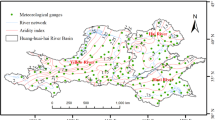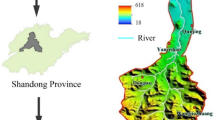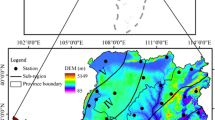Abstract
According to the meteorological observation data of 72 stations from 1960 to 2010 in the Huanghe (Yellow) River Watershed, China, the long-term variations of potential evapotranspiration, calculated in the modified Penman-Monteith model of Food and Agriculture Organization of the United Nations, were presented, as well as the meteorological causes for the decrease of potential evapotranspiration were discussed. Since 1960, temperature has risen significantly and potential evapotranspiration a decreasing trend, which indicated the existence of “Evaporation paradox” in the Huanghe River Watershed. This phenomenon was not consistent spatially or temporally with the increase of temperature, potential evapotranspiration decreased in spring, summer and winter, mainly over most parts of Shanxi and Henan, and some parts of Gansu, Ningxia, Inner Mongolia, and Shaanxi. During the recent half century, the trends of temperature and potential evapotranspiration were negatively correlated at most of the stations, while precipitation and potential evapotranspiration exhibited a contrary trend. Calculated in multiple regressions, the contribution to potential evapotranspiration change of related meteorological factors was discussed, including mean pressure, maximum and minimum temperature, sunshine hours, relative humidity and average wind speed. The decrease of wind speed in the Huanghe River Watershed may be the dominating factor causing potential evapotranspiration decreasing.
Similar content being viewed by others
References
Allen R G, Pereira L S, Raes D et al., 1998. Crop evapotranspiration guidelines for computing crop water requirements. FAO Irrigation and Drainage Paper (No.56). Rome FAO, 15–64.
Chattopadhyay N, Hulme M, Leclerc M Y, 1997. Evaporation and potential evapotranspiration in India under conditions of recent and future climate change. Agricultural and Forest Meteorology, 87: 55–73.
Chen S Y, Shi Y Y, Guo Y Z et al., 2010. Temporal and spatial variation of annual mean air temperature in arid and semiarid region in northwest China over a recent 46 year period. Journal of Arid Land, 2(2): 87–97.
Cohen S, Stanhill G, 2002. Evaporative climate changes at Bet-Dagan Israel, 1964–1998. Agricultural and Forest Meteorology, 111: 83–91.
Cong Zhentao, Ni Guangheng, Yang Dawen et al., 2008. Evaporation paradox in China. Advances in Water Science, 19(2): 147–152. (in Chinese)
Du J, Hu J, Liu Y L et al., 2008. Changes of pan evaporation and its impact factors in middle reaches of the Yarling Zangbu River over Tibet in recent 25 years. Journal of Natural Resources, 23(1): 120–126. (in Chinese)
Gao G, Chen D L, Ren G Y et al., 2006. Trend of potential evapotranspiration over China during 1956 to 2000. Geographical Research, 25(3): 379–387. (in Chinese)
Gao G, Chen D L, Xu C Y et al., 2007. Trend of estimated actual evapotranspiration over China during 1960-2002. Journal of Geophysical Research, 112, D11120, doi: 10.1029/2006JD008010.
Guo S L, Guo J, Zhang J et al., 2009. VIC distributed hydrological model to predict climate change impact in the Hanjiang Basin. Science China (Series E), 52(11): 3234–3239.
Horel J D, 1981. A rotated principal component analysis of the interannal variability of the Northern Hemisphere 500 mb height field. Mon. Wea. Rev, 109(10): 2080–2092.
Hu H R, Mao X L, Liang L, 2009. Temporal and spatial variations of extreme precipitation events of flood season over Sichuan Basin in last 50 years. Acta Geographica Sinica, 64(3): 278–288. (in Chinese)
Huang J Y, 1988. The application of REOF method to the weather and climate analyses. Meteorological Monthly, 14(9): 47–51. (in Chinese)
IPCC, 2001. Climate Change 2001: The Scientific Basis, Contribution of Working Group I to the Third Assessment Report of the International Panel on Climate Change. In: Houghton J T ed. New York: Cambridge University Press, 193–227.
Jesen M E, Bruman R D, Allen R G, 1990. Evapotranspiration and irrigation water requirements. ASCE Manuals and Reports on Engineering Practice (No.70). New York: American Society of Civil Engineers, 87–108.
Liu C M, Zhang D, 2011. Temporal and spatial change analysis of the sensitivity of potential evapotranspiration to meteorological influencing factors in China. Acta Geographica Sinica, 66(5): 579–588. (in Chinese)
Liu C M, Zhang X Y, Zhang Y Q, 2002. Determination of daily evaporation and evapotranspiration of winter wheat and maize by large-scale weighing lysimeter and micro-lysimeter. Agricultural and Forest Meteorology, 111: 109–120.
Liu S M, Sun Z P, Li X W et al., 2003. A comparative study on models for estimating evapotranspiration. Journal of Natural Resources, 18(2): 161–167. (in Chinese)
Liu Y, Cai L G, 1997. New definition and comparative analysis of calculation method of reference evapotranspiration. Journal of Hydraulic Engineering, 6: 27–33. (in Chinese)
Mao F, Zhang G Z, Xu X D, 2000. Several methods of calculating the reference evapotranspiration and comparison of their results. Quarterly Journal of Applied Meteorology, 11(suppl.): 128–136. (in Chinese)
Michael L R, Graham D F, 2004. Changes in Australian pan evaporation from 1970 to 2002. International Journal of Climatology, 24: 1077–1090.
Milan G, Slavisa T, 2010. Software for estimating reference evapotranspiration using limited weather data. Computers and Electronics in Agriculture, 71(2): 158–162.
Moonen A C, Ercoli L, Mariotti M et al., 2002. Climate change in Italy indicated by agrometeorological indices over 122 years. Agricultural and Forest Meteorology, 111: 13–27.
Ohmura A, Wild M, 2002. Is the hydrological cycle accelerating? Science, 298: 1345–1346.
Qiu X F, Liu C M, Zeng Y, 2003. Changes of pan evaporation in the recent 40 years over the Yellow River Basin. Journal of Natural Resources, 18(4): 437–442. (in Chinese)
Roderick M L, Farquhar G D, 2002. The cause of decreased pan evaporation over the past 50 years. Science, 298(15): 1410–1411.
Roderick M L, Farquhar G D, 2005. Changes in New Zealand pan evaporation since the 1970s. International Journal of Climatology, 25: 2031–2039.
Shao X M, Xu Y Q, Yan C R, 2006a. Wavelet analysis of rainfall variation in the Yellow River Basin. Acta Scientiarum Naturalium Universitatis Pekinensis, 42(4): 503–509. (in Chinese)
Shao X M, Yan C R, Wei H B, 2006b. Spatial and temporal structure of precipitation in the Yellow River Basin based on Kriging method. Chinese Journal of Agrometeorology, 27(2): 65–69. (in Chinese)
Shi J G, Yan C R, He W Q et al., 2007. Study on spatiotemporal change of evapotranspiration in the Yellow River Basin. Arid Zone Research, 24(5): 773–778. (in Chinese)
Solomon S, Qin D, Manning M et al., 2007. Climate Change 2007: The Physical Science Basis, Contribution of Working Group I to the Fourth Assessment Report of the Intergovernmental Panel on Climate Change. Cambridge, UK and New York, USA: Cambridge University Press.
Sun R, Liu C M, Li X W, 2003. Estimation of rvapotranspiration in the Yellow River Basin using integrated NDVI. Journal of Natural Resources, 18(2): 155–161. (in Chinese)
Wang Shaowu, Luo Yong, Zhao Zongci et al., 2005. On debates concerning the global warming. Progress in Natural Science, 15(8): 917–922. (in Chinese)
Wang X H, Guo M H, Xu X Y et al., 2012a. Changing trends of reference crop evapotranspiration and impact factors in Yunnan Mengzhi Plain in recent 50 years. Procedia Earth and Planetary Science, 5: 326–334.
Wang Y J, Jiang T, Xu C Y et al., 2006. Spatial-temporal change of 20 cm pan evaporation over the Yangtze River Basin. Advances in Water Science, 17(6): 830–833. (in Chinese)
Wang Y L, Wang X, Zheng Q Y et al., 2012b. A comparative study on hourly real evapotranspiration and potential evapotranspiration during different vegetation growth stages in the Zoige wetland. Procedia Environmental Sciences, 13: 1585–1594.
Wei F Y, Cao H X, Wang L P, 2003. Climatic warming process during 1980s-1990s in China. Journal of Applied Meteorological Science, 14(1): 79–86. (in Chinese)
Wu S H, Yin Y H, Zheng D et al., 2005. Study on dry-wet conditions of land surface in China in recent 30 years. Science in China (Series D), 35(3): 276–283. (in Chinese)
Xing X G, Shi W J, Song X Y, 2012. The annual and interannual variation of reference crop evapotranspiration of Panjin area. Procedia Engineering, 28: 331–335.
Yin Y H, Wu S H, Dai E F, 2010. Spatial and temporal attribution of potential evapo-transpiration China during the period of 1971–2008. Chinese Science Bulletin, 55(2): 2226–2234. (in Chinese)
Yin Y H, Wu S H, Zheng D et al., 2005. The regional differences of dry-wet change in China in recent 30 years. Chinese Science Bulletin, 50(15): 1636–1642. (in Chinese)
Zeng L H, Song K S, Zhang B, 2011. Spatial and temporal structure of water deficit over Northeast China during the period of 1951–2008. Journal of Natural Resources, 26(5): 858–870. (in Chinese)
Zhang D, Zhang W C, Xu Q Z, 2005. Comparison and modification of evapotranspiration estimation method in upper Hanjiang Basin. Resources Science, 27(1): 97–103. (in Chinese)
Zhang M J, Li R X, Jia W X et al., 2009. Temporal and spatial changes of potential evaporation in Tianshan mountains from 1960 to 2006. Acta Geographica Sinica, 64(7): 798–806. (in Chinese)
Zhang S H, Liu S X, Mo X G et al., 2010. Assessing the impact of climate change on potential evapotranspiration in Aksu River Basin. Journal of Geographical Sciences, 21(4): 609–620. (in Chinese)
Zhang X M, Yang J H, Gao W D et al., 2008. Climate characteristic of summer extremely heavy precipitation over Gansu Province in recent half century. Arid Meteorology, 26(2): 48–52. (in Chinese)
Zhou X D, Zhu Q J, Sun Z P et al., 2002. Preliminary study on regionalization desertification climate in China. Journal of Natural Disasters, 11(2): 125–131. (in Chinese)
Zuo D K, 1990. A Modern Dictionary of Geography. Beijing: The Commercial Press. (in Chinese)
Zuo H C, Li D L, Hu Y Q et al., 2005. Relationship of the climate change and pan evaporation in the recent 40 years in China. Chinese Science Bulletin, 50(11): 1125–1130. (in Chinese)
Author information
Authors and Affiliations
Corresponding author
Additional information
Foundation: National Natural Science Foundation of China, No.41161012; Program for New Century Excellent Talents in University by the Ministry of Education of China, No.NCET-10-0019; Basic Scientific Research Foundation in University of Gansu Province
Author: Ma Xuening (1987–), MS Candidate, specialized in global change and sustainable development.
Rights and permissions
About this article
Cite this article
Ma, X., Zhang, M., Li, Y. et al. Decreasing potential evapotranspiration in the Huanghe River Watershed in climate warming during 1960–2010. J. Geogr. Sci. 22, 977–988 (2012). https://doi.org/10.1007/s11442-012-0977-3
Received:
Accepted:
Published:
Issue Date:
DOI: https://doi.org/10.1007/s11442-012-0977-3




